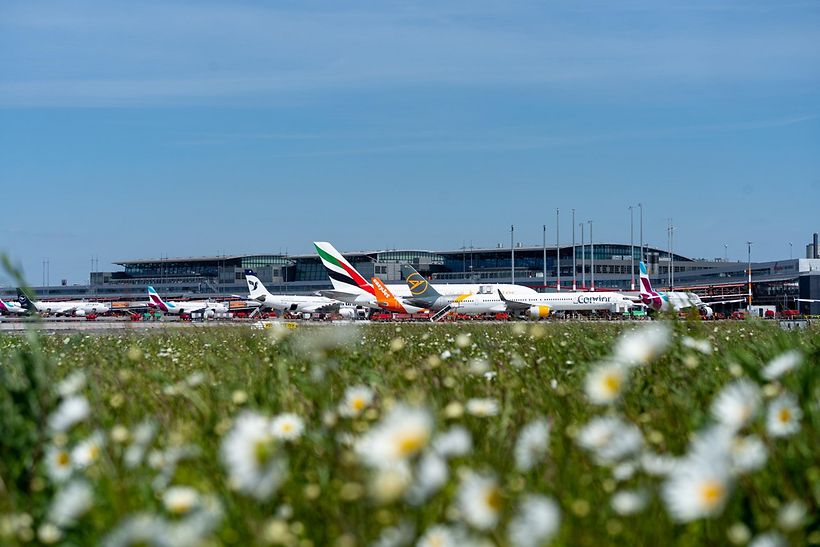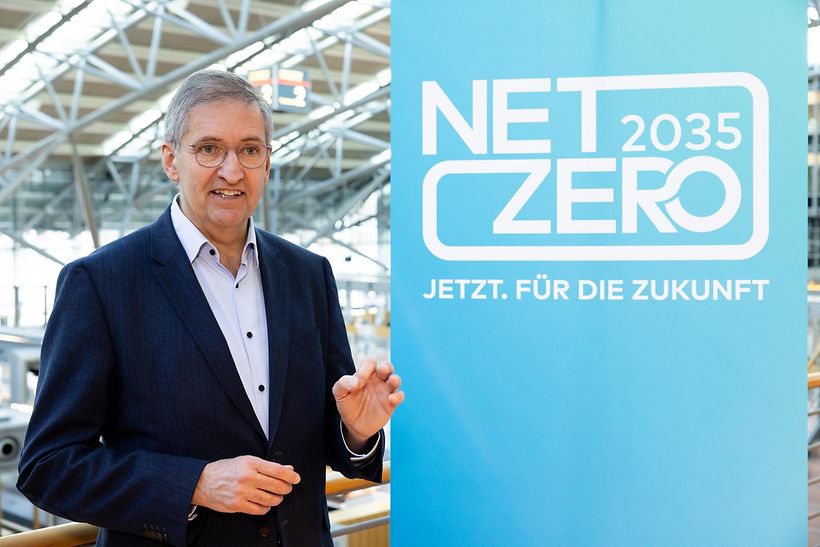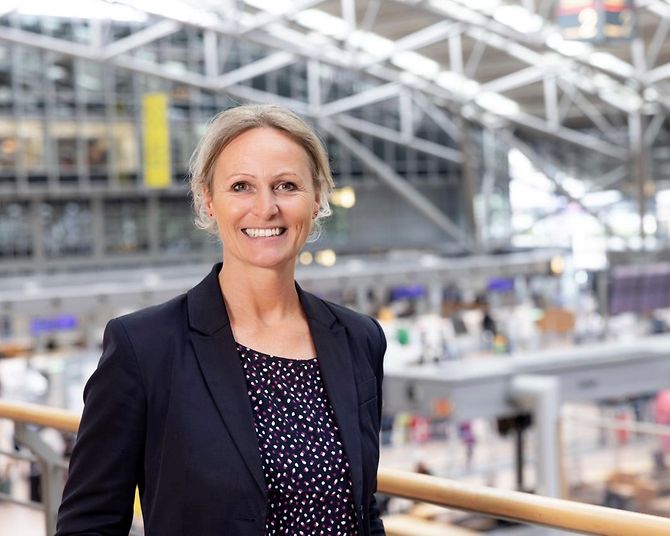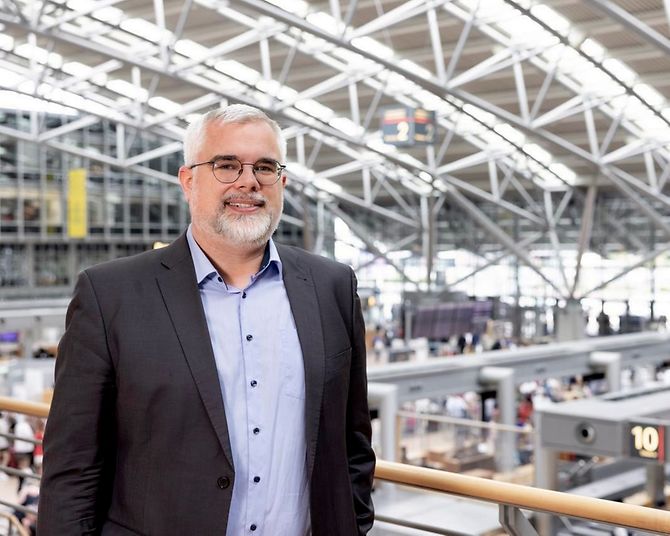Presentation of 2022 Balance Sheet and Investment Programme for Climate Protection
Airport significantly reduces losses and invests up to 250 million euros in “Net Zero 2035”
Strong increase in demand improves airport balance sheet despite coronavirus // Hamburg Airport puts on some pace: Airport city to be 100 percent converted to renewable energy by 2035 // Own wind park to deliver green electricity
29.03.2023
The coronavirus pandemic shaped the 2022 business year: Hamburg Airport’s bottom line was drawn in red for the third year running – but this time the loss, amounting to 27.2 million euros, was significantly lower than forecast. As a result of the rapid increase in demand for air travel, the airport’s turnover increased by 87.8 million euros (+68.2 percent) over the previous year. The airport is looking forward with confidence, and has its sights set on a momentous future project: Over the next twelve years, Hamburg Airport aims to reduce the fossil-based CO2 emissions of the airport city, step by step, to zero. The climate protection project encompasses investments of up to a quarter of a billion euros. Alone the construction of an airport-owned wind park close to Kaltenkirchen alone has received an allocation of around 70 million euros.
“After the end of the coronavirus restrictions, demand grew so rapidly, so strongly last year, that the number of passengers almost doubled compared to 2021. Our most important goal now is to bring the company back into the commercial profit zone as quickly as possible, and we are looking ahead with confidence and boldness,” says Michael Eggenschwiler, CEO of Hamburg Airport. “With our major climate and investment programme, ‘Net Zero 2035’, we are taking the next step in our consistent climate strategy.”
Result significantly exceeds original expectations
Hamburg Airport concluded the 2022 financial year with a loss of 27,2 million euros. The forecast was for a loss of 41 million euros, meaning that the result was some 34 percent better than expected. Sales revenue grew to 216.7 million euros. That represents growth of 87.8 million euros, or 68.2 percent, over the previous year. The balance sheet total declined to 715.3 million euros, a decrease of 89.1 million euros (11.1 percent). This is primarily attributable to the reduction of liabilities and repayment of loans. Commercially, Hamburg Airport was already on the way to breaking even this year, but due to the major rise in energy costs and high inflation, this milestone is expected to take a little longer.
“Net Zero 2035 – Now. For the future.” — Hamburg Airport sets the pace
For the years ahead, the airport is once again taking bold steps, consistently pursuing its ambitious climate protection goals. “In order to be able to operate without fossil greenhouse gas emissions in the future, we are investing up to a quarter of a billion euros over the next twelve years. Step by step, we are converting to independent, 100 percent renewable energy and heat generation for our airport city,” declares Michael Eggenschwiler, CEO of Hamburg Airport. Alone the construction of an airport-owned wind park close to Kaltenkirchen alone has received an allocation of around 70 million euros. At the same time, the airport is supporting the airlines in the field of climate-friendly aviation.
By 2035: airport city to reduce fossil-driven CO2 emissions to zero
Europe’s airports, working together under the umbrella of the Airports Council International Europe (ACI), have agreed to reduce their fossil-driven greenhouse gas emissions to zero by the year 2050. Hamburg Airport is part of this and is setting the pace. The goal: Hamburg Airport aims to be the first major German airport to be CO2-free, reaching this ambitious target as early as 2035. In order to reach this net zero target, the airport has developed its own route to reduction. The plan shows a timeframe for implementing decarbonisation, with four pillars key to achieving the goal. One step at a time, the plan is being implemented. “Net Zero 2035 is an ambitious but achievable target, thanks to our climate protection measures, established over several decades and continually being adapted and adjusted,” explains Michael Eggenschwiler, CEO of Hamburg Airport.
How Hamburg Airport is reducing CO2:
Four pillars for Net Zero 2035 Overall, the implementation of the climate protection measures for Net Zero 2035 is built on four pillars:
- Change in heating supply: In the future, heat for the airport city will be provided by a network of a heat distribution network, biogas, electrode boilers and deep geothermics.
- Vehicle conversions:The airport fleet will be completely converted to emission-free electric and hydrogen power, including a hydrogen fuel station on the site.
- Future-proof electricity supply: By constructing its own wind energy park at Heidmoor on the airport’s own property, along with a photovoltaic facility, the airport city is to have an independent, 100-percent sustainable energy supply.
- Energy efficiency: Additional energy-saving potential can be found in operational facilities by optimising usage, expanding monitoring and replacing systems and equipment where necessary.
Wind park to provide the airport city with green electricity
“The most important pillar is a conversion of the heat and electricity supply for the airport city, moving away from gas to renewable solutions. In order to achieve net zero by 2035, we are planning, for example, to construct the Heidmoor Wind Park on an airport property near Kaltenkirchen, and we are investigating opportunities for photovoltaics,” reports Michael Eggenschwiler. Taken together, this will see the airport and its 100 buildings powered with in-house green electricity by 2028 already. The region can benefit from the locally produced energy, too. Surplus regional wind energy can be used for in-house hydrogen production.
Climate-friendly flight: Hamburg Airport supports the airlines
Hamburg Airport is not only considering its own surface emissions; its sights are set much wider. To support air traffic itself on the path to a CO2-free future, Hamburg Airport is sponsoring the development of alternative fuels for aviation, and its modern Schedule of Fees & Charges provides incentives for airlines to move to aircraft with efficient technologies. This reduces per-passenger kerosene consumption. Within just a few
years, the proportion of aircraft of the latest generation operating at Hamburg Airport has risen from 2 to 12 percent, and the upward trend continues.
In addition, Hamburg Airport is involved in the Hydrogen Aviation Lab, the engine behind the development of future generations of aircraft with hydrogen-based engines. It is forecast that these aircraft will be in operation by the middle of the 2030s. On top of this, service techniques and ground procedures for hydrogen technology are being developed and tested at Hamburg Airport to prepare for maintenance and handling of hydrogen-oowered aircraft. “We are actively working to ensure that aircraft with green power can be taking off from Hamburg as soon as possible. The next development projects with international partners are already being planned,” says Eggenschwiler.
Net Zero means: no more offsets
With its “Net Zero 2035 – Now. For the future.” climate strategy, Hamburg Airport is once again underlying its pioneering role. For more than three decades, the airport has been home to innovative environmental efforts and committed to reducing CO2 emissions. With demonstrable success: since March 2022, the airport has had CO2-neutral operations, the first major German airport to achieve this, and now it is taking yet another decisive step. In contrast to CO2 neutrality, where remaining emissions are offset, Net Zero means that, with technical changes and energy reductions, the CO2 emissions arising from operation of the airport’s buildings, facilities and vehicles is being reduced, step by step, to zero.
Outlook for 2023: airport expects around 13.8 million passengers
For the current year, Hamburg Airport expects demand to continue to grow, with a total of around 13.8 million passengers. In the summer holiday season, too, the airport expects more passengers than last year. More than 350,000 passengers per week are forecast for July. In order to cope with this high demand, Hamburg Airport is turning to technical solutions and personnel support from local partners wherever possible. One of these technical solutions is the Slot & Fly project. Already for the Easter holidays, passengers can reserve a 15-minute time slot for entering the security checkpoint, enabling them to better plan their journey. The current waiting time for the security checkpoint, down to the minute, can also be seen on the website. A peak hour display will soon be introduced, too, similar to those typically found on the internet for shops. This will allow passengers to see precisely when the airport is more, or less, crowded.
Contact persons for journalists / media
-
Telefon:
+49 (0)40 5075 3611E-Mail:
presse@ham.airport.de -
Telefon:
+49 (0)40 5075 3615E-Mail:
kbromm@ham.airport.de -
Telefon:
+49 (0)40 5075 3680E-Mail:
jniemeyer@ham.airport.de -
Telefon:
+49 (0)40 5075 3671E-Mail:
pwolf@ham.airport.de





